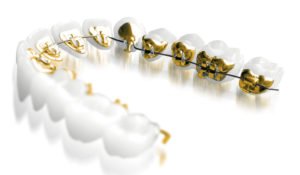The pros and cons of lingual braces

Lingual braces are traditional fixed braces that are fitted behind your teeth. They’re a relatively new innovation, especially if you consider that Egyptian mummies have been found wearing brace-like appliances! They were invented in the 1970s by two orthodontists simultaneously; one was based in Japan and the other in the United States.
Lingual braces took a while to gain popularity, because although they were discreet, they were quite bulky and initially not even that great at straightening teeth. This has all changed though and lingual braces can now compete with the best of them. And when it comes to discreetness, they win hands down, pipping clear aligners like Invisalign (below) to the post.

The advantages of lingual braces
- It’s important to emphasise that lingual braces are very discreet. We can’t say that they’re invisible, because that would be impossible, but they’re definitely the next best thing. Because they’re attached behind your teeth, there’s no metal wires or brackets on view – and some of our patients go through their entire treatment without friends and colleagues noticing their braces.
- Because lingual braces are essentially fixed braces, they remain in place throughout your treatment. This means they’re always straightening your teeth, and you don’t need to worry about wearing them for so many hours each day. It also makes them impossible to lose. Some patients also appreciate that unlike removable aligners, you don’t need to take them out for eating or drinking.
- The latest lingual braces, like the Incognito brace (below), feature custom-made brackets that perfectly fit your teeth. This provides excellent control and allow us to achieve precise movements. Lingual braces can treat a wide range of problems including severely crowded teeth, spacing and teeth that don’t bite together properly. That’s not to say they’re not a great choice for simple problems too. We even offer lingual braces that are specially designed to straighten just the front teeth: Incognito™ Lite and STb social 6.

- Occasionally patients can stain their teeth while wearing braces, usually by eating and drinking the wrong things. It only really becomes a problem when the braces are removed, revealing tiny white squares where the brackets were protecting the teeth. Similarly, decalcification can also occur as a result of poor oral hygiene during treatment, resulting in white spots. If either was to happen while wearing lingual braces, any stains would be conveniently hidden behind your teeth.
The disadvantages of lingual braces
- Lingual braces are usually more expensive than traditional braces and clear aligners. This is because the cost of the brace itself is usually higher, particularly if the brackets are custom-made, or gold, as is the case with Incognito braces. Lingual orthodontics also requires clinicians to undergo dedicated training to learn the technique, and because lingual braces aren’t quite as accessible as traditional braces, appointments to adjust your brace can take longer.
- While some might consider a fixed brace an advantage, others could also see this as a disadvantage. Because removable braces can be taken out for eating, this means you can eat anything and everything during your orthodontic treatment. With a lingual brace, however, you need to avoid anything hard, chewy, crusty – essentially anything that could dislodge one of your brackets. If a bracket does come off, and it’s been custom-made, we’ll need to organise a replacement, which could extend the length of your treatment.
- There’s not bags of room behind your teeth, so the addition of a brace, no matter how well it has been designed, will not go unnoticed. You might find that for the first week you experience some initial soreness and parts of your brace may irritate your tongue. It should get better every day, and we can also give you some special wax, which you can pop over any parts of your brace that are rubbing.
- Just after your brace has been fitted you might also develop a lisp. Again, this shouldn’t last longer than a few days and we can give you some tips to help you adjust. The more you talk, the quicker the problem should resolve itself.
To find out more about the pros and cons of all our braces, come and see us for a free consultation*. We’ll answer all your questions and provide you with a no-obligation quote for your chosen treatment.



